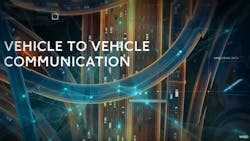Processing Platform Streamlines Connected Vehicle Data
Check out our CES 2022 coverage.
The Overview
Wejo, which specializes in cloud and software analytics generated from connected-vehicle data (CVD), is developing a Wejo Neural Edge platform that will enable intelligent handling of data from vehicles at scale, while providing insights that protect privacy and empower automotive innovation.
Who Needs It & Why?
Today’s vehicles—whether autonomous (AV), electric (EV), or connected (CV)—generate an enormous amount of data from radar, LiDAR, sensors, and so on. Within that vast data set is the opportunity for making roads radically safer. There’s data of great utility to vehicle makers, municipal planners, insurance companies, and, most importantly, motorists themselves. Wejo’s Neural Edge platform aims to streamline and standardize that data, collect it and push it to the cloud, and enable much more effective and efficient vehicle-to-vehicle (V2V) and vehicle-to-infrastructure (V2X) communications.
Under the Hood
Wejo’s Neural Edge platform, which is being developed in collaboration with Microsoft Azure, will filter and analyze the vast dataset generated by vehicles before transmitting only essential information to the cloud. Using machine-learning algorithms to reconstruct vehicle journey and event data, Wejo Neural Edge can take 20% of the data from connected vehicles and reconstruct it to represent 100% of the data, without any loss in data fidelity or integrity. The positive environmental impact is significant, as less data requires less storage which in turn reduces power consumption.
The Wejo platform will filter and analyze vast amounts of AV, EV, and CV data before transmitting only the essential information to the cloud. This is made possible by utilizing in-car edge processing that Wejo is developing to filter only useful and valuable CVD before it is transmitted to the cloud.
The embedded software technology, in combination with Microsoft Azure, will enable Wejo Neural Edge to power automotive innovation by:
- Reducing network and storage costs for the auto manufacturers by optimizing the data coming from the vehicle: Leveraging embedded software within the vehicle chipset, Wejo Neural Edge is designed to intelligently choose and prioritize the data to be sent from the vehicle to the cloud.
- Enabling V2V and V2X communications: Wejo Neural Edge enables the standardization and centralization of the data that comes from autonomous, electric, and connected vehicles. Not only does this provide a key building block for communication in near-real time, but it also supports communication with infrastructure services such as road signs, traffic lights, and parking lots, so vehicles can easily anticipate the road ahead and optimize mobility experiences.
- Delivering a digital twin of the vehicle and cities: Digital twins can reshape how we view the entire product and service ecosystem related to mobility. In a simulation environment, a digital twin of the U.S. can be constructed to simulate how vehicles in different cities need to respond and navigate without having to outlay massive infrastructure costs of physical hardware or vehicles to be able to relearn how a vehicle should behave in smart cities.
Further details about the availability of the Wejo Neural Edge Processing platform will come at a future date.
About the Author
David Maliniak
Executive Editor, Microwaves & RF
I am Executive Editor of Microwaves & RF, an all-digital publication that broadly covers all aspects of wireless communications. More particularly, we're keeping a close eye on technologies in the consumer-oriented 5G, 6G, IoT, M2M, and V2X markets, in which much of the wireless market's growth will occur in this decade and beyond. I work with a great team of editors to provide engineers, developers, and technical managers with interesting and useful articles and videos on a regular basis. Check out our free newsletters to see the latest content.
You can send press releases for new products for possible coverage on the website. I am also interested in receiving contributed articles for publishing on our website. Use our contributor's packet, in which you'll find an article template and lots more useful information on how to properly prepare content for us, and send to me along with a signed release form.
About me:
In his long career in the B2B electronics-industry media, David Maliniak has held editorial roles as both generalist and specialist. As Components Editor and, later, as Editor in Chief of EE Product News, David gained breadth of experience in covering the industry at large. In serving as EDA/Test and Measurement Technology Editor at Electronic Design, he developed deep insight into those complex areas of technology. Most recently, David worked in technical marketing communications at Teledyne LeCroy, leaving to rejoin the EOEM B2B publishing world in January 2020. David earned a B.A. in journalism at New York University.

